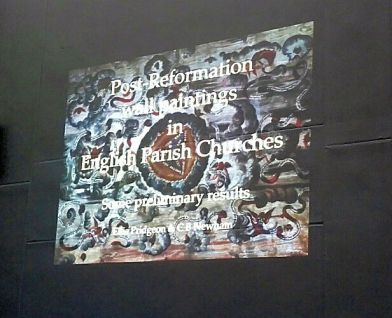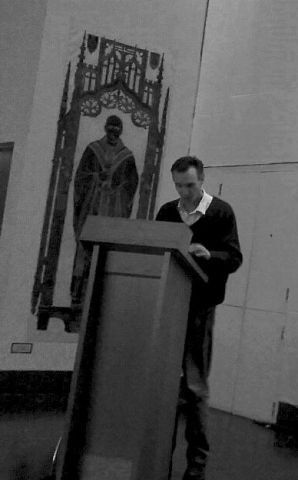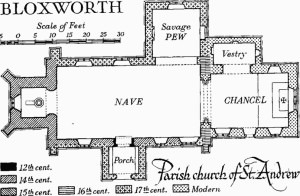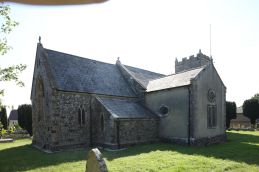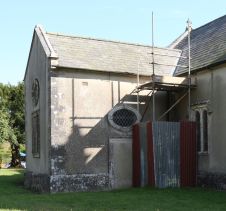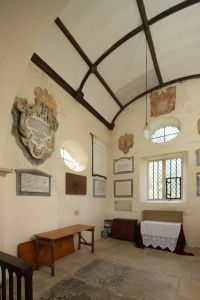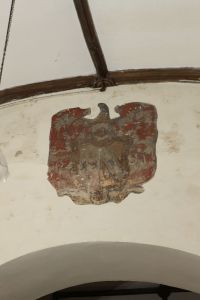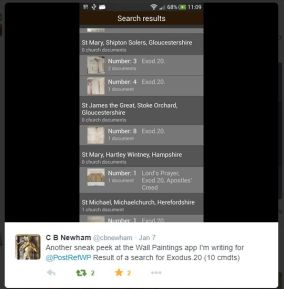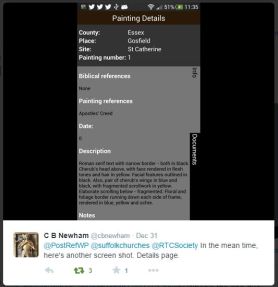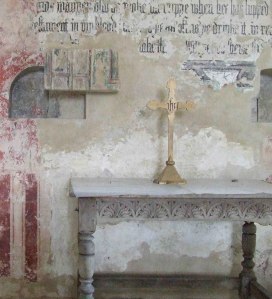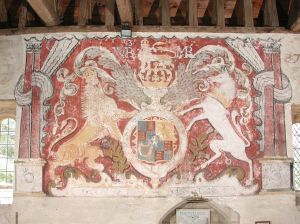Over the last six months, the PRWP team has catalogued hundreds of church murals in every county of England, ranging from Cornwall to Northumberland. The most outstanding and intriguing examples so far, certainly in terms of preservation and sheer artistic quality, are the murals at St. Lawrence’s church in Mereworth (Kent).
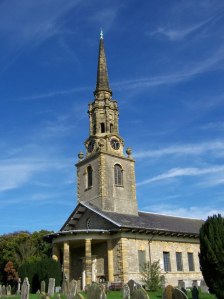
Mereworth Church
Architectural History
Mereworth church was completed in 1746, a date which provides a terminus post quem for the interior paintwork. The building was commissioned by John Fane, 7th Earl of Westmorland, who had employed Scottish architect Colen Campbell (d.1729) in the 1720s to rebuild Mereworth Castle as a Palladian villa. The medieval church, which stood on the site of the stables, was pulled down in the 1740s as it was considered to disturb the symmetry of the new house. The present church was erected on a new site about half a mile away near the centre of the village.

West End Portico, Mereworth
The Neo-Classical church is a rectangular building with a semi-circular portico, a high steeple, no chancel, and an east-end Diocletian window (derived from the Diocletian Baths in Rome). The Neo-Palladian building draws on the work of Inigo Jones, as well as on the designs by Nicholas Hawksmoor and Thomas Archer for the ‘Commission for Building Fifty New Churches’ in London (1710).
There is some disagreement about the identity of the Mereworth church architect. Possibly, the building was designed by Henry Flitcroft (d.1769), whose portfolios include St Giles-in-the-Fields (London), as well as Alfred’s Tower and the Temples of Ceres, Hercules and Apollo at Stourhead (Wiltshire). Another candidate is Roger Morris (d.1749), Colen Campbell’s assistant, who designed the Column of Victory at Blenheim Palace, Wimbledon House, and the Palladian Bridge at Wilton House (Wiltshire).
The Paintings
Inside, the church walls are painted using a trompe l’oeil technique to create architectural illusions. The yellow and brown colour scheme of the walls give the effect of plaster, while the nave columns are painted to give appearance of marble. A series of trompe l’oeil garlands and wreaths are positioned above windows and blind tabernacles in nave and aisles.
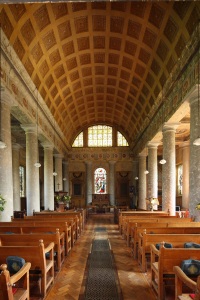
Nave Looking East, Mereworth
A trompe l’oeil frieze with triglyphs and metopes runs round the nave, containing roundels with images of the Dove, the IHS monogram and the Jehovah tetragrammaton. The crowning masterpiece is the coffered trompe l’oeil painting on barrel vault ceiling, which spans the entire width and length of nave.
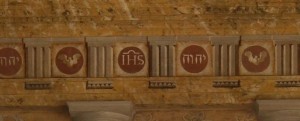
Frieze, Mereworth
A series of large trompe l’oeil flower heads encircled by garlands and foliage patterns are painted on the north and south aisle ceilings, rendered in a monochrome colour scheme.
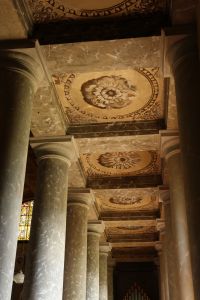
Painted Ceiling, Mereworth
Above the west doorway is a lunette with a trompe d’oeil organ in the centre, its pipes painted in silver, grey and white. A cherub’s head appears at the top of the central column, and two further cherubs flank the organ on both sides, each holding billowing drapery.
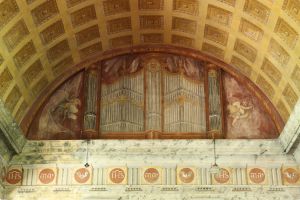
Painted Frieze, Lunette and Ceiling, Mereworth
Context, Creation and Chronology
The Mereworth paintings are significant, not least because they were probably commissioned by the Earl of Westmorland as an integral part of the church design. It is likely that they were executed immediately after completion of the church as they were in situ in 1752 when the writer and politician Horace Walpole visited Lord Westmorland. Walpole’s contemptuous remarks about the paintings reflect commonplace contemporary attitudes to the Neo-Classical style:
‘The inside is the most abominable piece of tawdriness that ever was seen, stuffed with pillars painted in imitation of verd antique, as all the sides are like Sienna marble; but the greatest absurdity is a Doric frieze, between the triglyphs of which is the Jehovah, the I.H.S. and the Dove’.
As is the case with the vast majority of post-Reformation wall painting, the artist responsible for the Mereworth church paintings remains unidentified.
Select Bibliography
Hasted, E., ‘Parishes: Mereworth’, in The History and Topographical Survey of the County of Kent, Vol. 5 (Canterbury, 1798), 70-90: British History Online: www.british-history.ac.uk/survey-kent/vol5/pp70-90 (Accessed 23 December 2014).
Lane, G., ‘Panel of the Month: William Price, The Glass at Mereworth and the Pigott Panel at the V&A’, Vidimus, Issue 55 (2011): http://vidimus.org/issues/issue-55/panel-of-the-month (Accessed 23 December 2014).
Wells, A., The Parish Church of St Lawrence, Mereworth (Church Guide, Revised 2011).
Wright, J., ed., The letters of Horace Walpole, Earl of Orford: Including Numerous Letters Now First Published from the Original Manuscripts, Vol. 2 (Nabu Press, 2012), 444.
British Listed Buildings: www.britishlistedbuildings.co.uk/en-178886-church-of-st-lawrence-mereworth-kent (Accessed 23 December 2014).
